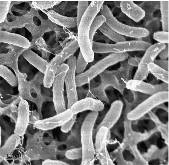|
Intake of Iodine and Perchlorate and Excretion in Human Milk
|
journal
|
November 2008 |
|
Kinetics of a chlorate-accumulating, perchlorate-reducing bacterium
|
journal
|
May 2008 |
|
Reduction of (per)chlorate by a novel organism isolated from paper mill waste
|
journal
|
August 1999 |
|
Biological Denitrification in Microbial Fuel Cells
|
journal
|
May 2007 |
|
Physiological and taxonomic description of the novel autotrophic, metal oxidizing bacterium, Pseudogulbenkiania sp. strain 2002
|
journal
|
June 2009 |
|
Dechloromonas hortensis sp. nov. and strain ASK-1, two novel (per)chlorate-reducing bacteria, and taxonomic description of strain GR-1
|
journal
|
September 2005 |
|
NOTE: Phylogenetic analysis of Formivibrio citricus, Propionivibrio dicarboxylicus, Anaerobiospirillum thomasii, Succinimonas amylolytica and Succinivibrio dextrinosolvens and proposal of Succinivibrionaceae fam. nov.
|
journal
|
April 1999 |
|
Detection of Perchlorate and the Soluble Chemistry of Martian Soil at the Phoenix Lander Site
|
journal
|
July 2009 |
|
Widespread Presence of Naturally Occurring Perchlorate in High Plains of Texas and New Mexico
|
journal
|
May 2006 |
|
Perchlorate reduction in a HYDROGEN-BASED MEMBRANE-BIOFILM REACTOR
|
journal
|
November 2002 |
|
The Biochemistry and Genetics of Microbial Perchlorate Reduction
|
book
|
January 2006 |
|
Isolation and characterization of autotrophic, hydrogen-utilizing, perchlorate-reducing bacteria
|
journal
|
September 2004 |
|
Perchlorate and Iodide in Dairy and Breast Milk
|
journal
|
April 2005 |
|
Transformation of (per)chlorate into chloride by a newly isolated bacterium: reduction and dismutation
|
journal
|
April 1996 |
|
Propionivibrio limicola sp. nov., a fermentative bacterium specialized in the degradation of hydroaromatic compounds, reclassification of Propionibacter pelophilus as Propionivibrio pelophilus comb. nov. and amended description of the genus Propionivibrio.
|
journal
|
March 2002 |
|
Fermentation of maleate by a gram-negative strictly anaerobic non-spore-former, Propionivibrio dicarboxylicus gen. nov., sp. nov.
|
journal
|
September 1990 |
|
Culture-Dependent and Culture-Independent Characterization of Microbial Assemblages Associated with High-Temperature Petroleum Reservoirs
|
journal
|
February 2000 |
|
Adapting a denitrifying biocathode for perchlorate reduction
|
journal
|
November 2008 |
|
Perchlorate reduction by a novel chemolithoautotrophic, hydrogen-oxidizing bacterium
|
journal
|
October 2002 |
|
Microbial perchlorate reduction: rocket-fuelled metabolism
|
journal
|
July 2004 |
|
Azonexus caeni sp. nov., a denitrifying bacterium isolated from sludge of a wastewater treatment plant
|
journal
|
May 2006 |
|
Identification of an anaerobic bacterium which reduces perchlorate and chlorate asWolinella succinogenes
|
journal
|
January 1996 |
|
Molecular Characterization of Methanotrophic Isolates from Freshwater Lake Sediment
|
journal
|
December 2000 |
|
Perchlorate in Wet Deposition Across North America
|
journal
|
February 2009 |
|
MRBAYES: Bayesian inference of phylogenetic trees
|
journal
|
August 2001 |
|
Widespread Natural Perchlorate in Unsaturated Zones of the Southwest United States
|
journal
|
July 2007 |
|
Strong Release of Methane on Mars in Northern Summer 2003
|
journal
|
February 2009 |
|
Electrochemical Stimulation of Microbial Perchlorate Reduction
|
journal
|
March 2007 |
|
Review: Direct and Indirect Electrical Stimulation of Microbial Metabolism
|
journal
|
June 2008 |
|
Fermentative bacteria from estuarine mud: Phylogenetic position of Acidaminobacter hydrogenoformans and description of a new type of Gram-negative, propionigenic bacterium as Propionibacter pelophilus gen. nov., sp. nov.
|
journal
|
July 1999 |
|
Mobilization of Naturally Occurring Perchlorate Related to Land-Use Change in the Southern High Plains, Texas
|
journal
|
December 2008 |
|
Environmental Factors That Control Microbial Perchlorate Reduction
|
journal
|
September 2002 |
|
Preferential cultivation of type II methanotrophic bacteria from littoral sediments (Lake Constance)
|
journal
|
February 2004 |
|
Reassessment of the taxonomic structure of the diazotrophic genus Azoarcus sensu lato and description of three new genera and new species, Azovibrio restrictus gen. nov., sp. nov., Azospira oryzae gen. nov., sp. nov. and Azonexus fungiphilus gen. nov., sp. nov
|
journal
|
March 2000 |
|
Anaerobic benzene oxidation coupled to nitrate reduction in pure culture by two strains of Dechloromonas
|
journal
|
June 2001 |
|
A novel ecological role of the Firmicutes identified in thermophilic microbial fuel cells
|
journal
|
September 2008 |
|
MUSCLE: multiple sequence alignment with high accuracy and high throughput
|
journal
|
March 2004 |
|
Dechloromonas denitrificans sp. nov., Flavobacterium denitrificans sp. nov., Paenibacillus anaericanus sp. nov. and Paenibacillus terrae strain MH72, N2O-producing bacteria isolated from the gut of the earthworm Aporrectodea caliginosa
|
journal
|
May 2005 |
|
MrBayes 3: Bayesian phylogenetic inference under mixed models
|
journal
|
August 2003 |
|
Perchlorate in Dairy Milk. Comparison of Japan versus the United States
|
journal
|
January 2007 |
|
Sustained Perchlorate Degradation in an Autotrophic, Gas-Phase, Packed-Bed Bioreactor
|
journal
|
July 2000 |
|
Kinetics of a hydrogen-oxidizing, perchlorate-reducing bacterium
|
journal
|
October 2006 |
|
Molecular and biological characterization of an isolate of the potyvirus passiflora virus Y naturally infecting soybean (Glycine max) in Brazil
|
journal
|
September 2022 |
|
(Per)chlorate Reduction by the Thermophilic Bacterium Moorella perchloratireducens sp. nov., Isolated from Underground Gas Storage
|
journal
|
November 2007 |
|
Rapid Assay for Microbially Reducible Ferric Iron in Aquatic Sediments
|
journal
|
January 1987 |
|
Ubiquity and Diversity of Dissimilatory (Per)chlorate-Reducing Bacteria
|
journal
|
December 1999 |
|
Effect of Model Sorptive Phases on Phenanthrene Biodegradation: Different Enrichment Conditions Influence Bioavailability and Selection of Phenanthrene-Degrading Isolates
|
journal
|
July 2000 |
|
High-Throughput Methods for Culturing Microorganisms in Very-Low-Nutrient Media Yield Diverse New Marine Isolates
|
journal
|
August 2002 |
|
Metabolic Primers for Detection of (Per)chlorate-Reducing Bacteria in the Environment and Phylogenetic Analysis of cld Gene Sequences
|
journal
|
September 2004 |
|
Identification, Characterization, and Classification of Genes Encoding Perchlorate Reductase
|
journal
|
July 2005 |





